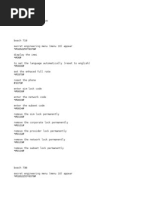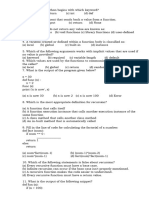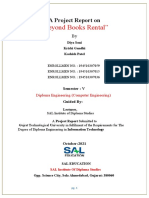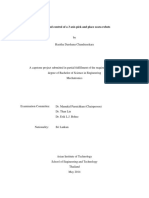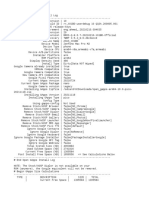0 ratings0% found this document useful (0 votes)
3 viewsComputer Science Practice Questions-1, Functions
This document contains practice questions on functions in computer science, aimed at preparing students for their Board Examination. It includes various types of questions, such as identifying valid function headers, understanding void functions, and analyzing code outputs. Additionally, it provides guidelines for answering the questions and submitting queries to teachers.
Uploaded by
blackwarrior.05082005Copyright
© © All Rights Reserved
Available Formats
Download as PDF, TXT or read online on Scribd
0 ratings0% found this document useful (0 votes)
3 viewsComputer Science Practice Questions-1, Functions
This document contains practice questions on functions in computer science, aimed at preparing students for their Board Examination. It includes various types of questions, such as identifying valid function headers, understanding void functions, and analyzing code outputs. Additionally, it provides guidelines for answering the questions and submitting queries to teachers.
Uploaded by
blackwarrior.05082005Copyright
© © All Rights Reserved
Available Formats
Download as PDF, TXT or read online on Scribd
You are on page 1/ 3
Computer Science
Practice Questions
Topic: Functions
Full Marks 20
NOTE
• You are advised against doing selective study.
• The questions given above are sample questions for practice prior to Board Examination.
• Although Answer Keys will be provided within 2-3 days of posting of these questions, you are
advised to answer them yourself.
• In case you have queries regarding a portion of the chapters being revised here you may send
your query to your teacher through Chat section in MS Teams.
1. Which of the following is a valid function header? 1
a. def interest (P, R=10, T):
b. def circle area (rad):
c. def loop ( n ):
d. def sort ( [5, 9, 3, 1, 7] )
2. Which of the following is a valid statement? 1
a. A void function does not have a parameter list
b. A void function does not return anything
c. A void function neither receives any parameters nor returns any value
d. A void function has no function body
3. During a function call, keyword arguments 1
a. Should be placed before positional arguments
b. Can be placed anywhere as arguments
c. Should be placed after positional arguments
d. Can be placed in-between positional arguments
4. Default parameter in a function: 1
a. Is used when no argument is passed for that parameter
b. Is used irrespective of whether an argument is passed to the function or not
c. Should be placed on the left of positional parameters
d. Are a must in the parameter list
5. The global keyword: 1
a. Is used to access a global variable inside a function
b. Is used to place a variable in the global name space
c. Is used to declare a function parameter as global
d. Is used to call a function with a global argument
6. Find the output of the following code: 2
def find( a, b ):
global c
a = a+b
b = b+c
c = c+a
print(a, b, c)
#main
a = 3
b = 5
c = 10
find( a, b )
print(a, b, c)
7. Find the output of the following code: 2
def calc( x, y=5, z=6 ):
p = x+y * z
r = p + x+y+z//3
return p, r
#main
a = calc( 1, 8, 3 )
print(a)
b = calc( 4 )
print(b)
8. Find the output of the following code: 2
def new( S ):
T = ''
n = len(S)
for i in range(n):
if S[i].isdigit():
T += S[i]*2
elif S[i].isspace():
T += '#'
elif S[i].isalpha():
T += S[i].upper()
else:
T += '*'
print(T)
#main
new('@5.3% Disc')
9. Find the output of the following code: 2
def modify( s ):
n = ''
for c in s:
if c.isupper():
n += chr(ord(c) + 2)
elif c.islower():
n += chr(ord(c) - 2)
elif c.isdigit():
n += str( int(c) * 2 )
else:
n += '2'
return n
#main
print( modify('Fri@23') )
10. Find the output of the following code: 2
def F1(n):
if n in [2, 7, 4, 9]:
return 5*n - 2
elif n in [3, 5, 1, 6]:
return 3*n + 2
else:
return 2*n - 2
#main
num = 2854
new = 0
while num != 0:
d = num%10
new = new + F1(d)
num //= 10
print(new)
11. Rectify the errors in the following code and rewrite the code by underlining the corrections made: 2
def func(n, t r=6):
while t<n
if t = r: break
t += 1
else:
t = t+r
return t
12. Define a function that receives a list and reverses all the even numbers in the list and creates a new
list. The new list is returned. If received list is [24, 71, 864, 37], then returned list is [42, 71, 468, 37]. 3
Date of posting answer key: 22/01/2025
You might also like
- The C# Player's Guide - 5th Edition - 5.0.083% (18)The C# Player's Guide - 5th Edition - 5.0.0497 pages
- Introduction To Computer Theory by Cohen Solutions Manual80% (5)Introduction To Computer Theory by Cohen Solutions Manual198 pages
- Ap Computer Science Principles Practice Exam and Notes 202186% (7)Ap Computer Science Principles Practice Exam and Notes 2021108 pages
- Hacking The Art of Exploitation 2nd Edition Jon Erickson100% (20)Hacking The Art of Exploitation 2nd Edition Jon Erickson492 pages
- PrepTest 83 - Print and Take Test - 7sage Lsat100% (3)PrepTest 83 - Print and Take Test - 7sage Lsat46 pages
- ComputerScience-Practice Paper Set (Chinhat)No ratings yetComputerScience-Practice Paper Set (Chinhat)7 pages
- Advanced C++ Interview Questions You'll Most Likely Be AskedFrom EverandAdvanced C++ Interview Questions You'll Most Likely Be AskedNo ratings yet
- Python Revision Material - CH.1,2.3.5.9No ratings yetPython Revision Material - CH.1,2.3.5.931 pages
- QB For Final Revision - CS - XII - 2020 Part-2No ratings yetQB For Final Revision - CS - XII - 2020 Part-260 pages
- Practice Paper Class-Xii Sub-Comp - SC Time:1 HR F.M: 35 Section-ANo ratings yetPractice Paper Class-Xii Sub-Comp - SC Time:1 HR F.M: 35 Section-A5 pages
- Final Review Worksheet: CMSC 201 Spring 2019 NameNo ratings yetFinal Review Worksheet: CMSC 201 Spring 2019 Name5 pages
- Practice paper - Computer Science 2024 QP copyNo ratings yetPractice paper - Computer Science 2024 QP copy11 pages
- E.G. - If Input Is (12, 54, 49, 86, 23, 36) Then Modified List Is (32, 18, 16, 106, 43, 12)No ratings yetE.G. - If Input Is (12, 54, 49, 86, 23, 36) Then Modified List Is (32, 18, 16, 106, 43, 12)6 pages
- Coding With JavaScript For Dummies Everything To Know About JavaScript (2020) - 40153100% (1)Coding With JavaScript For Dummies Everything To Know About JavaScript (2020) - 40153247 pages
- NWO, Illuminati, Freemason, Occult, Bible Prophecy, Conspiracy, Secret Society, Etc. LinksNo ratings yetNWO, Illuminati, Freemason, Occult, Bible Prophecy, Conspiracy, Secret Society, Etc. Links47 pages
- Structured and Unstructured Maintenance With Example0% (1)Structured and Unstructured Maintenance With Example9 pages
- Python Programming For Beginners - A Crash Course To Learn Python and Other Recommended Coding83% (6)Python Programming For Beginners - A Crash Course To Learn Python and Other Recommended Coding86 pages
- LINUX COMMAND LINE An Introduction To Linux Command Line EnvironmentNo ratings yetLINUX COMMAND LINE An Introduction To Linux Command Line Environment174 pages
- Learn To Code HTML and CSS Develop Style Websites PDF100% (2)Learn To Code HTML and CSS Develop Style Websites PDF595 pages
- How To Use PATS Module Initialization FunctionNo ratings yetHow To Use PATS Module Initialization Function5 pages
- Data Structure & Algorithms: Prepared By: EishaNo ratings yetData Structure & Algorithms: Prepared By: Eisha35 pages
- Anthropic's Claude 3: Revolutionizing Complex Visual Data AnalysisNo ratings yetAnthropic's Claude 3: Revolutionizing Complex Visual Data Analysis8 pages
- Foreign Currency Setting: Configuration DocumentNo ratings yetForeign Currency Setting: Configuration Document5 pages
- PLT-04333 A.3 - FARGO HDP5000 Windows Printer Driver Release NotesNo ratings yetPLT-04333 A.3 - FARGO HDP5000 Windows Printer Driver Release Notes5 pages
- SFC 20 From Standard and System FunctionsNo ratings yetSFC 20 From Standard and System Functions3 pages
- Alumni System Final Year Project For ITNo ratings yetAlumni System Final Year Project For IT61 pages
- TYIT - Software Project Management - Unit 3 Chapter 6 Activity PlanningNo ratings yetTYIT - Software Project Management - Unit 3 Chapter 6 Activity Planning18 pages
- Emd Steps For Varrious Tasks: 1. Creation of EmployeeNo ratings yetEmd Steps For Varrious Tasks: 1. Creation of Employee7 pages
- 3BDS013986-600 en System 800xa For AC 100 6.0 Aspect Object Types PDFNo ratings yet3BDS013986-600 en System 800xa For AC 100 6.0 Aspect Object Types PDF194 pages
- Multitasking Operation SYSTEM - 2023EV149: Dharsan S (201CS146)No ratings yetMultitasking Operation SYSTEM - 2023EV149: Dharsan S (201CS146)8 pages
- 8 Websites to Download Online Book PDF for Free - FlipHTML5No ratings yet8 Websites to Download Online Book PDF for Free - FlipHTML513 pages
- Basic Pentesting - 2 - CTF Walkthrough - Infosec ResourcesNo ratings yetBasic Pentesting - 2 - CTF Walkthrough - Infosec Resources9 pages
- React 18 Design Patterns and Best Practices, Fourth Edition (Early Access) Anonymous download100% (2)React 18 Design Patterns and Best Practices, Fourth Edition (Early Access) Anonymous download40 pages








